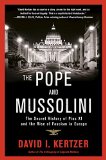Summary | Excerpt | Reviews | Beyond the Book | Readalikes | Genres & Themes | Author Bio
The Secret History of Pius XI and the Rise of Fascism in Europe

Critics' Opinion:
Readers' Opinion:
First Published:
Jan 2014, 576 pages
Paperback:
Dec 2014, 592 pages
 Book Reviewed by:
Book Reviewed by:
Linda Hitchcock
Buy This Book
The conclave that year turned into a showdown between two factions. On one side were those cardinals dubbed the zelanti, the intransigents. They looked back nostalgically to the days of Pius X, eager to resume the Church's crusade against the evils of modern times. On the other side, the moderates, dubbed the "politicians," hoped to continue Benedict XV's more middle-of-the-road and outward-looking policies. Pius X's secretary of state, Rafael Merry del Val, led the zelanti. Pietro Gasparri, Benedict's secretary of state, was the champion of the moderates. The conclave was shaping up as an epic battle over the direction the Catholic Church would take in the twentieth century, made all the more dramatic by the uncertainty of its outcome. It seemed doubtful that either faction could obtain the two-thirds vote required for election, and there was no obvious compromise candidate.
If Cardinal Gasparri was sometimes called the pecoraio, the shepherd, it was not in the pastoral sense. Sixty-nine years old at the time of the conclave, he came from a peasant family in a small sheep-raising village in the Apennine Mountains of central Italy. The nickname—which he delighted in himself—came with the Italian connotations of being a country hick, a parvenu amid the sophisticates of the Vatican hierarchy. When he was a child, his family followed its herd into the mountains each spring, returning each fall to the valley, where they sent Pietro to the local parish priest for school lessons. A bright child, he entered Church seminaries for his later education, but unlike many in the high Vatican diplomatic service, he did not attend Rome's prestigious Pontifical Academy of Noble Ecclesiastics, which traditionally drew on sons of the aristocracy.
Gasparri grew into a short, rotund adult, a priest who seemed to move without his feet ever leaving the ground. His dress "showed an unusual indifference to neatness." But he was popular with the diplomatic corps, making up in bonhomie what he lacked in polish. Gesticulating broadly, eyes sparkling, and laughing often, he was constantly pushing his red skullcap back into place. Gasparri saw himself—and was seen by others—as having a mountain peasant's shrewdness, intuition, tenacity, and capacity for hard work. "His black, intelligent eyes," one observer noted, "betrayed his finesse."
On the evening of February 2, the conclave began in the Sistine Chapel; each of the fifty-three cardinals was provided with a seat at his own small table. Among those absent were the two cardinals from the United States, still on a ship somewhere in the Atlantic. The thirty-one Italians constituted a majority, and only with strong Italian support could anyone be elected. At the altar at the front of the chapel stood a large crucifix and six burning candles. Every time a vote was called, the cardinals approached the altar one at a time, in order of seniority. At the foot of the altar, each got down on his knees, spent a moment in prayer, and recited a Latin vow pledging to choose the man whom he believed God would want elected. He deposited his folded paper ballot and then bowed before the cross before returning to his seat.
Two votes were held each morning and two in the afternoon. Three cardinals, chosen by lot, counted the ballots. Over the next days, the solemn rite was repeated fourteen times, marred only once when, as he rose from his chair, a Dominican cardinal bumped into his table, draining an ink bottle over his white cassock.
Twelve cardinals received votes. On the second day, Merry del Val reached what would be his high of seventeen. Gasparri received twenty-four votes by the sixth ballot but remained stuck at that number for the seventh and eighth as well. Outside the Vatican, a large crowd of Romans—both the curious and the devout—waited anxiously. "Only one thing is certain," the French paper Le Figaro reported, "no one knows anything." Cardinal Gasparri spent the night after the eighth ballot lying awake in bed, aware that he would never become pope. The following morning, before the third day of voting began, he went to see the conclave's most junior member, Achille Ratti. He told the surprised Ratti, who had been made a cardinal only a few months earlier, that he would urge his supporters to switch their votes to him.
Excerpted from The Pope and Mussolini by David I. Kertzer. Copyright © 2014 by David I. Kertzer. Excerpted by permission of Random House, a division of Random House LLC. All rights reserved. No part of this excerpt may be reproduced or reprinted without permission in writing from the publisher.





The Flower Sisters
by Michelle Collins Anderson
From the new Fannie Flagg of the Ozarks, a richly-woven story of family, forgiveness, and reinvention.

The House on Biscayne Bay
by Chanel Cleeton
As death stalks a gothic mansion in Miami, the lives of two women intertwine as the past and present collide.

The Funeral Cryer by Wenyan Lu
Debut novelist Wenyan Lu brings us this witty yet profound story about one woman's midlife reawakening in contemporary rural China.
Your guide toexceptional books
BookBrowse seeks out and recommends the best in contemporary fiction and nonfiction—books that not only engage and entertain but also deepen our understanding of ourselves and the world around us.